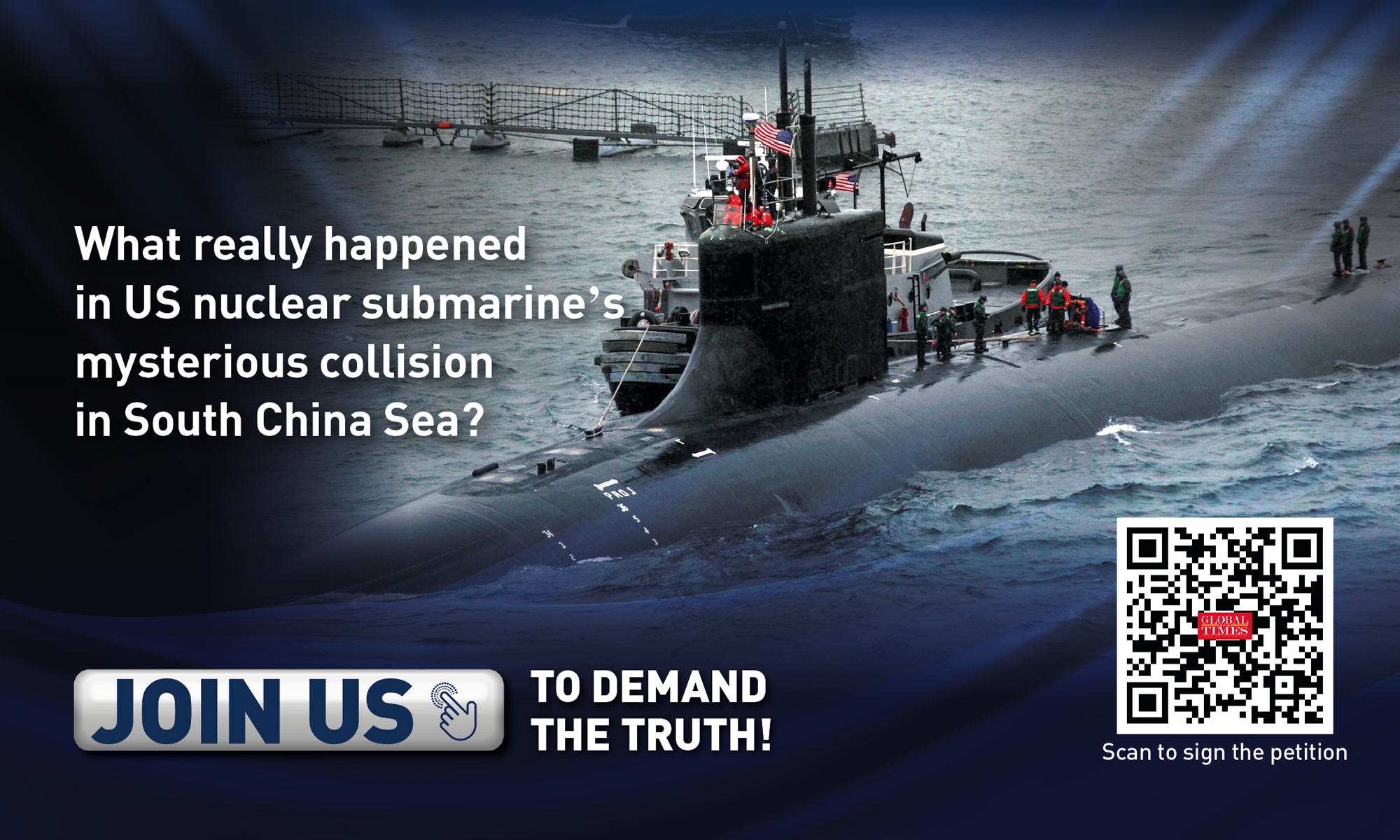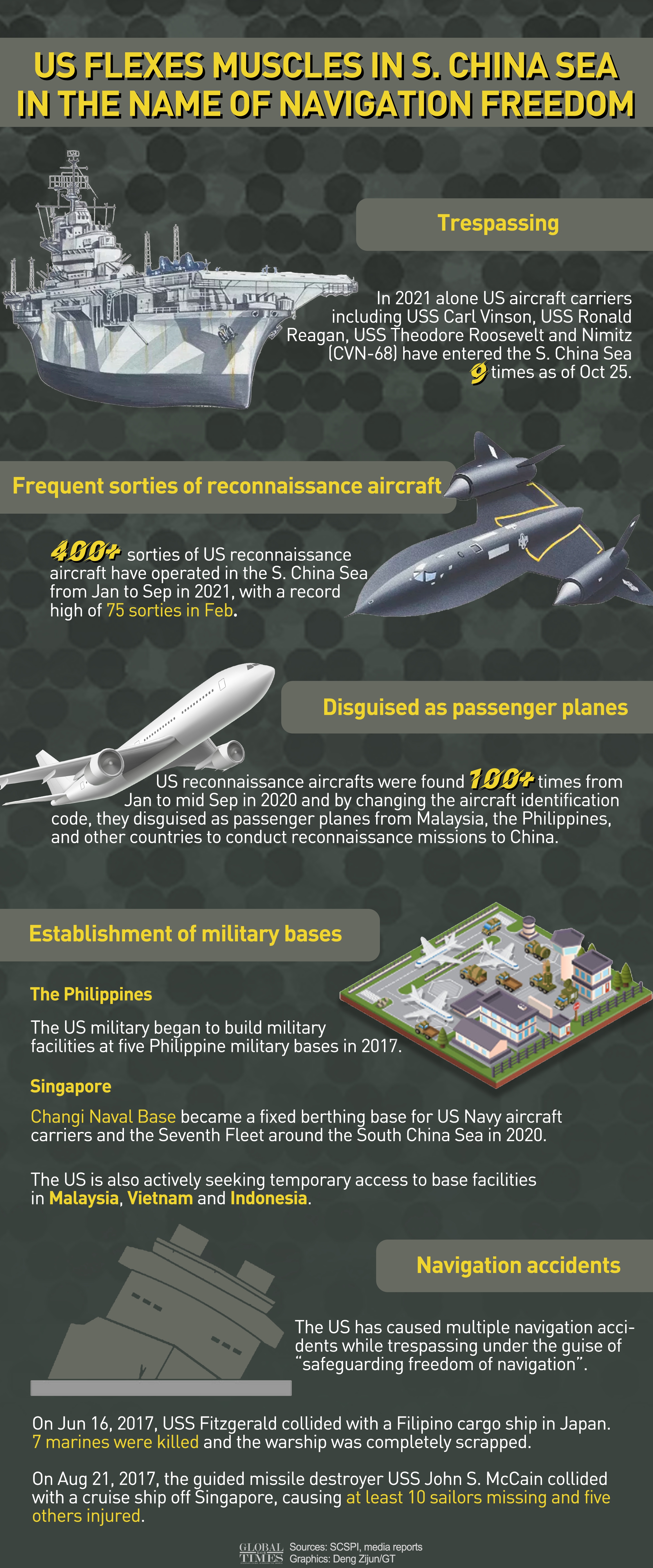
What really happened in US nuclear submarine's mysterious collsion in South China Sea?
More than three weeks have passed since the USS
Connecticut, a Seawolf-class nuclear-powered submarine of the US Navy, collided with an "unknown object" in the South China Sea, the US military still has not released basic information on the accident that is of concern to China and many other countries in the region. To find out the truth, the Global Times launched on Tuesday an
online petition, demanding the US military to reveal information on the collision.
The accident exposed intensive, hidden US military activities beyond freedom of navigation in the region, which could seriously damage navigation safety, fishing work, ecological environment, not to mention sovereignty violations in the South China Sea, experts said.
The US Navy announced on October 7 that the USS
Connecticut hit an "unknown object" on October 2 while submerged in the South China Sea that left more than 10 sailors injured and caused a partial damage to the submarine.
It took the US Navy five days after the accident to make this short and vague statement, and until today, the US military has not revealed further details of the accident. They haven't revealed the exact location where the collision happened and what object was hit by the submarine.
By not revealing the details of the collision, the US is intentionally hiding something, Wei Dongxu, a Beijing-based military expert, told the Global Times on Tuesday.
"The USS
Connecticut likely sailed to a location where it is not allowed to be for a covert spy operation, but failed to effectively grasp the underwater situation and resulted in the collision. The US knows it is in a wrong position so it cannot reveal the details," Wei said.
The US Navy is known for sailing carelessly in the South China Sea in the name of "freedom of navigation," and many of such activities are provocative and unprofessional, like crossing into other ships' normal sailing routes, trespassing into other navies' exercise zones and intruding into other countries' territorial waters, observers said.
US warships and submarines have caused many accidents that gravely harm navigation safety, including collisions with various objects or civilian ships on many occasions in recent years, the petition said, noting that these incidents have seriously threatened the safety of the life and property of local residents.
For example, in February 2001, the Los Angeles class nuclear-powered submarine USS
Greeneville struck and sank a Japanese fishing vessel identified as the Ehime Maru during routine operations off the coast of Hawaii, killing nine.
In 2017, the USS
Fitzgerald destroyer collided with a container ship near Japan, resulting in seven deaths and several injuries.
Later in 2017, the USS
John S. McCain destroyer collided with a chemical tanker in the South China Sea, leading to ten deaths.
In 2018, the USS
Decatur destroyer sailed very close to a Chinese destroyer and almost caused a collision when the US warship was attempting to trespass Chinese waters near Nansha Islands in the South China Sea.
Wei also pointed out that the USS
Connecticut is a nuclear-powered submarine, and any accident to a nuclear device, which carries highly enriched uranium, could result in severe damage to the environment.
The US has also not given any information about the effects of the collision on the ecological environment of the region, or if it had a negative impact on navigation safety and fishing work in the area, the petition said.
The collision exposed that, in addition to showing off its strength publicly, the US military has also been conducting numerous covert activities in the South China Sea, the petition said, noting that these activities are by no means "innocent" and pose a great threat to regional peace and stability often without the public's knowledge.
A lot of US naval activities are hegemonic moves that seriously violate the international law and disrespect other countries' sovereignty, Wei said.
Zhao Lijian, a spokesperson at the ministry, said at Tuesday's regular press conference that China and other countries along the South China Sea have the reason to demand the US to answer the following questions: What was the mission of the nuclear submarine in the South China Sea? What exactly did it collide with? Why did that happen? Did a nuclear leak take place and bring nuclear pollution to the maritime environment?
The US must explain the incident in detail so as to respond to the concerns and questions of countries in the region and the international community, Zhao told the Global Times when asked about the collision.
If the US refuses to reveal all the details about the collision, China and other relevant countries could be forced to build well-rounded maritime early warning systems to monitor US vessels in sensitive waters, so they can warn the US before it takes any risks, and be better prepared to deal with any dangers caused by the US, Wei said.
The US must reveal the truth behind the USS
Connecticut's collision because countries around the South China Sea have the right to know, the petition reads.

US flexes muscles in S. China Sea in the name of navigation freedom. Graphic:Deng Zijun/Global Times





